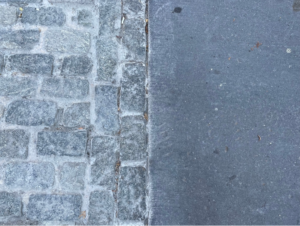
By: Maxwell Schuss
TriBeCa’s historic cobblestone streets might have you taking a different kind of ‘trip’ when you visit the neighborhood. After numerous incidents of residents injuring themselves, the city has begun the process of paving over the rugged, ankle-breaking streets. Manhattan Community Board 1 has voiced their concerns and is currently working with the city to prevent any more injuries and allow for the disabled to have a smooth crossing. Six crosswalks across the neighborhood will be paved over in compliance with the Americans with Disabilities Act.
John Croce, a 70-year-old TriBeCa resident, tripped over the cobblestones while crossing Harrison Street in October of 2018. Croce suffered multiple broken bones and later died due to complications from his injuries. Manhattan Community Board 1’s Quality of Life & Delivery Services Committee met on March 22, 2022 and reached the conclusion that “The Cobblestone Streets of TriBeCa need to be rebuilt as their current state is objectively dangerous whereby simple pedestrian use has already led to multiple examples of severe injury and one case leading to the death of a local resident from the simple act of walking on the cobbled roadway in its present state.” The sidewalk at the intersection of Hudson and Vestry has already been reconstructed and features non-skid pedestrian ramps on either side, a smooth granite pavement, as well as separated rows of cobblestones that mimic the aesthetic of the original streets.
Cobblestone streets throughout TriBeCa suffer from loose blocks, emerging depressions, and motor deterioration which all result in higher road maintenance costs compared with standard asphalt roadways. Member of the Executive Committee, Patricia L. Moore led the discussion at the community board meeting on cobblestone sidewalk reconstruction and emphasized the importance of safety interventions. “The cobblestone streets are exclusionary and do not permit the safe use of canes, walkers, mobility scooters, wheelchairs, strollers, or bicycles without the threat of tripping, equipment failure and excessive wear and tear,” said Moore.

Photo credit: Maxwell Schuss
The committee voted 11 in favor, 0 opposed during the community board meeting on March 22, 2022, to replacing the cobblestone sidewalks with asphalt as long as there are no preexisting historic protections for the streets. The problems and difficulties that arise from the cobblestones are “Inconsistent with the principles of universal access and inclusion that grow from earlier victories with the Americans with Disabilities Act of 1990,” according to the committee resolution. The ADA is a civil rights law that prohibits discrimination on the basis of disability within the United States. “These streets need to be safe and accessible to all,” said Moore.
Ethan Messina is a student at Hunter College who grew up in the Lower Manhattan area and is all too familiar with the treacherous cobblestone streets. “I was in middle school at the time and on my way to a friend’s house when I tripped on a cobblestone that was sticking up from the sidewalk,” he said. “I was holding a basketball in one hand my book bag in the other so I couldn’t brace my fall and fell right on my face.” Messina received only minor injuries from the fall but is still confused as to why the cobblestone streets remain. “I get they’re historic and have been there for years, but there’s a reason why they don’t make streets like that anymore,” he said.
The placing of the pavement is currently underway and “So far so good,” said Peter Roloff at the committee meeting, an engineer in charge at the NYC Department of Design and Construction Infrastructure. “We’re really getting into the nitty gritty of the major work and so far, we haven’t had any negative feedback from the community.” At the request of the Community Board, the city is constructing crosswalk upgrades at Jay and Staple Street, Laight and Collister, Jay and Greenwich, Harrison and Greenwich, Vestry and Washington, and Watts and Greenwich.
